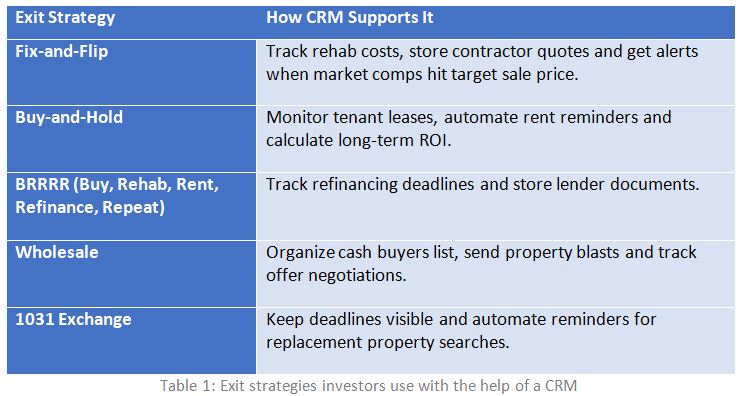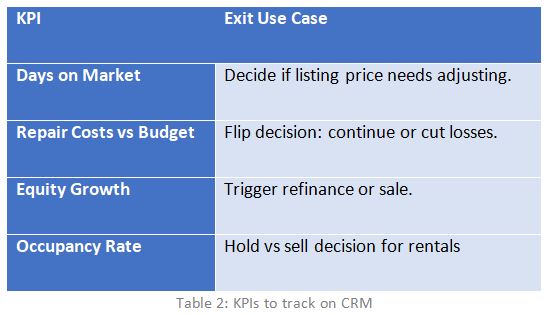
How Do Real Estate Investors Use CRMs to Build Exit Strategies for Properties?
How Do Real Estate Investors Use CRMs to Build Exit Strategies for Properties?
Smart investors know that profit is made at the exit and not just the entry. You can buy a property at the right price, rehab it beautifully and find good tenants. But if you do not have a clear exit strategy then stop relying on spreadsheets or gut instinct. Like every smart investor, use specialized Real Estate CRMs to design, track, and execute profitable exits.
TL;DR: Real estate investors use CRMs to design clear exit strategies. They can use this tool for tracking property performance, analyzing ROI and automating follow-ups. Investors decide when to flip, hold, refinance, or wholesale properties based on CRM data. Real estate CRM Platforms reduce errors and speed up decision-making for profitable exits. Ready to see it in action? Book your FREE demo today.
Why do real estate investors need exit strategies?
Exit strategies are investor roadmaps. These strategies answer when to sell or rent and at what price. Without one, investors deal with the following risks:
• Holding properties too long and bleeding cash flow.
• Selling too early and missing appreciation.
• Failing to pivot if the market shifts.
A CRM for wholesale real estate centralizes all this planning in one dashboard. It makes the exit decision faster and smarter.
How do real estate investors plan exit strategies through a CRM?
CRMs are no longer just digital address books. They act as deal command centers for investors. These tools power exit strategies in different ways:
1. Timeline Tracking
Timing is essential for a successful exit strategy. Investors can utilize a CRM to set rehab deadlines or holding period reminders. When you have a CRM to note everything, forget about scattered sticky notes or spreadsheets. The system will also get automated alerts to list a property, refinance, or even prepare for tenant turnover. This way you never miss a profitable window.
2. ROI Analysis
Deciding whether to sell or hold a property often comes down to numbers. Pete REI makes this easier by helping investors track key performance metrics and cash flow in real time. You can see how a property is performing against your targets inside your dashboard. These reports and insights tell you when a property is hitting profit goals. This kind of visibility helps investors make confident decisions.
3. Buyer & Lender Pipeline
Exit strategies depend on people. A CRM acts like a matchmaking system that keeps your buyers, private lenders, and agents engaged with automated follow-ups. When you are ready to exit a deal, you already know who is interested. Investors flip faster, refinance easier and wholesale properties effortlessly with this pipeline approach.
4. Data Driven Insights
Exit strategies must adjust to market changes. Pete REI gives investors KPI tracking and reporting tools to keep a close eye on performance. You can adjust your exit plan with clear visibility into trends and results. It means selling sooner or holding longer based on real performance data.

What is the biggest mistake investors make without a CRM?
The biggest mistake investors make without a CRM is relying on spreadsheets. This often leads to underpriced sales, forgotten follow-ups and even lost buyers. A CRM keeps everything organized in one place so investors can make faster, more profitable decisions.
What exit strategies do investors commonly use with CRMs?
Different investors have different goals. A CRM for real estate wholesalers adapts to all of them.

Can small investors use CRMs for exits, or is it only for large portfolios?
Even solo investors benefit. A CRM ensures they don’t miss refinancing deadlines, buyer follow-ups, or 1031 exchange timelines.
Can a CRM really predict the best time to exit?
Investors often ask- Can my CRM tell me when to sell? You should know that CRMs cannot predict the market but they analyze signals to guide timing:
• Equity Thresholds: The analytics and reporting tools in Pete REI allow you to monitor portfolio performance and set custom KPIs. It can help in tracking equity levels.
• Cash Flow Drops: The CRM offers analytics and reporting features. Use these to analyze key performance indicators and cash flow metrics.
• Buyer Readiness: Pete REI CRM allows you to manage leads and deals. You can automate workflows and assess buyer readiness.
A CRM doesn’t predict the market, but it uses ROI, equity, and market data so that you can identify the most profitable time to exit.
How do CRMs automate communication for exit strategies?
Automation in a CRM makes it the most powerful tool. Timely communication through automated follow ups is equally important for executing profitable exits.
• Automated Buyer Follow-Ups: Pete REI creates automated workflows that ensure consistent engagement with potential buyers.
• Lender Check-Ins: Schedule automated reminders to contact lenders so that refinancing deadlines and other critical milestones are not missed
• Contractor Updates: Automated task reminders during renovations can keep a project on track.
• Investor Reporting: Share exit timelines with partners via scheduled emails.

Which CRM features are most useful for exit planning?
The top features are: ROI calculators, task automation, pipeline management, and integrated market insights. Want to learn more about how these tools guide profitable decisions? Read this detailed guide on Pete REI CRM features [[Real Estate Investors Finally Have a CRM Made Just for Them].
What KPIs should investors track in a CRM for exits?
Investors must track Key Performance Indicators (KPIs) inside the CRM for an effective exit plan.
Properties that sit longer than 60 days may signal pricing or market issues. Check the Cost Per Lead to evaluate the efficiency of marketing efforts. Lower costs usually mean better ROI. Comparing Repair Costs vs Budget ensures renovations don’t eat into profits. A smart target would be to keep the repairs under 10–15% of the property value. Seasoned investors often aim for at least a 20% margin on flips. Rental Occupancy Rate ideally above 90% tells if holding or selling is more profitable. Tracking these KPIs through a CRM like Pete REI allows investors to spot trends and maximize returns.

Do real estate investors really need a CRM for exit strategies?
Spreadsheets can work for a few properties but they cannot scale with portfolios like a CRM. Use this tool to centralize data, automate reminders and keep investor teams aligned.
Final Thoughts
Your exit strategy is going to be as strong as the tools you use to back it up. Invest in a CRM for faster and more profitable decisions. Have the right system in place for flipping, holding, wholesaling or a 1031 exchange. It gives you the confidence to know when to move and how to maximize your returns.
If you want to take your investing game to the next level, choose a CRM built for real estate investors and sized for your portfolio. Pete REI is the best CRM for real estate wholesalers, in which you can choose the plan that fits your portfolio:
• Silver for solo investors with 1–5 properties
• Gold for small teams managing 5–15 properties
• Platinum for growing businesses with 15–50 properties
• Diamond for large portfolios with 50+ properties
The right plan will support your exits and will also help you create better ones.